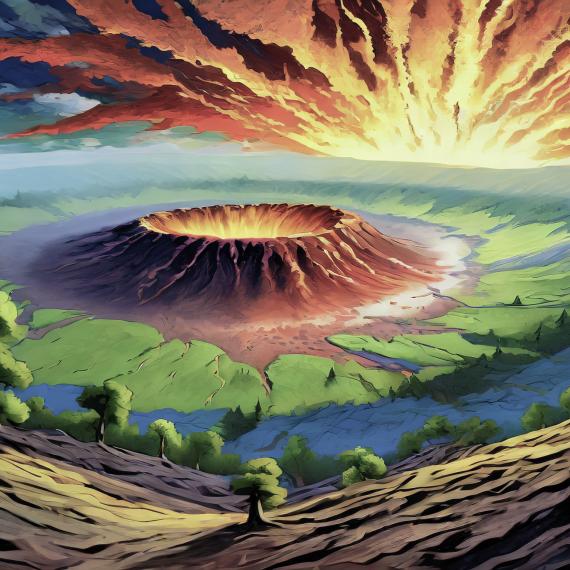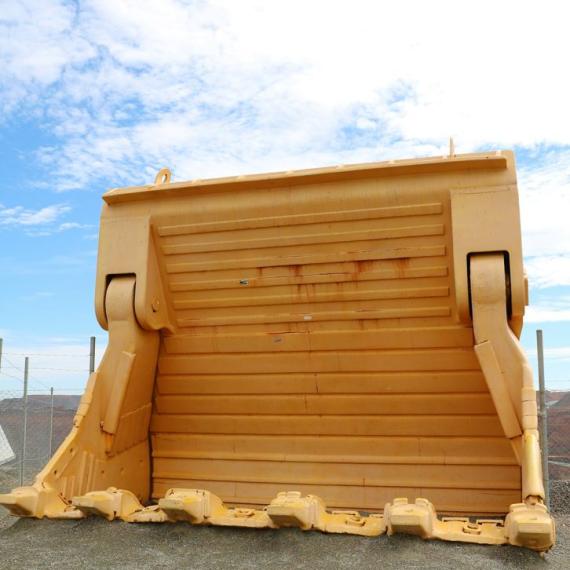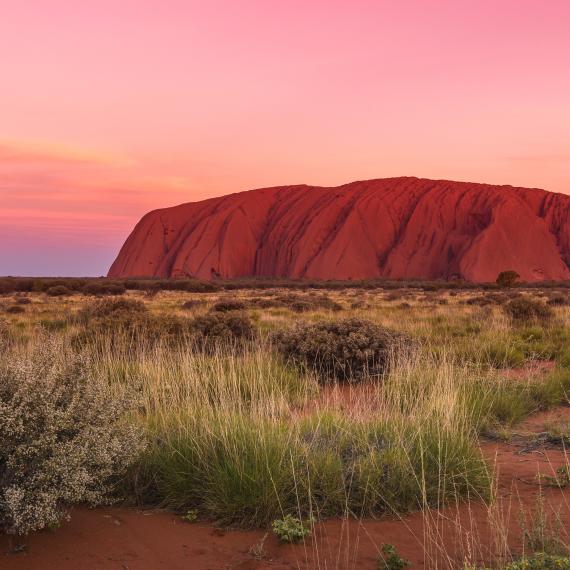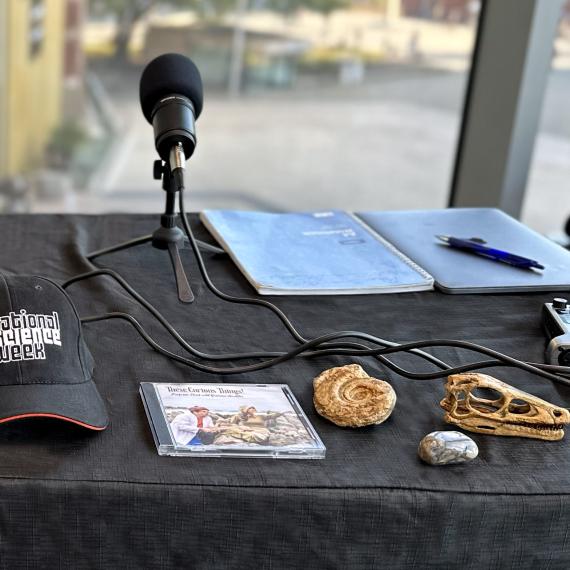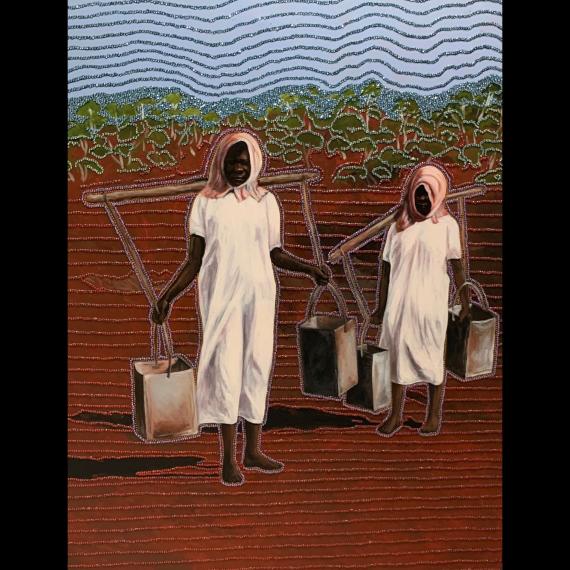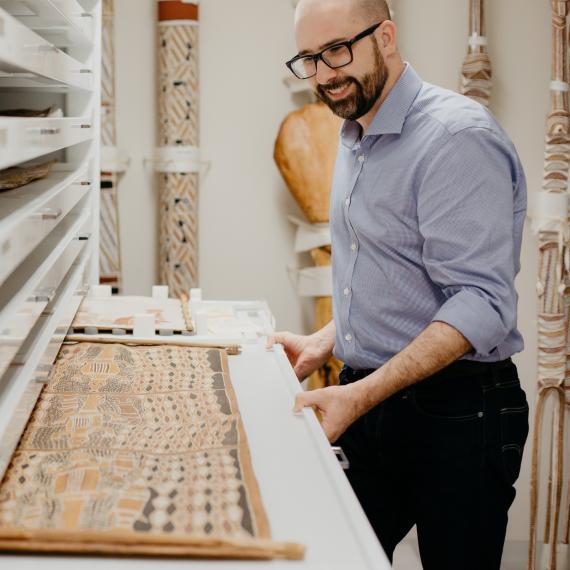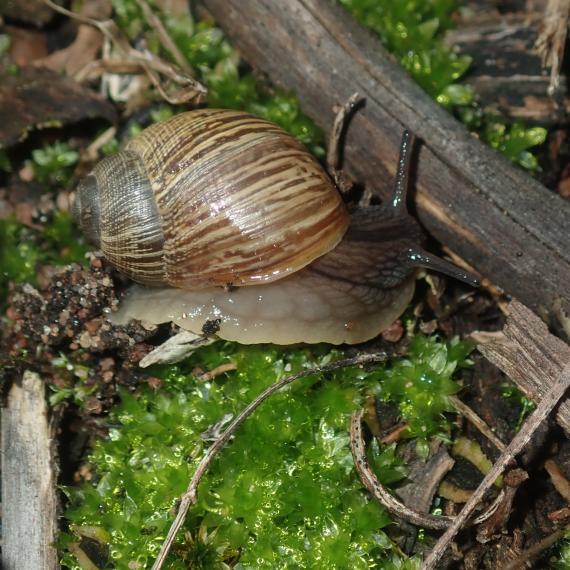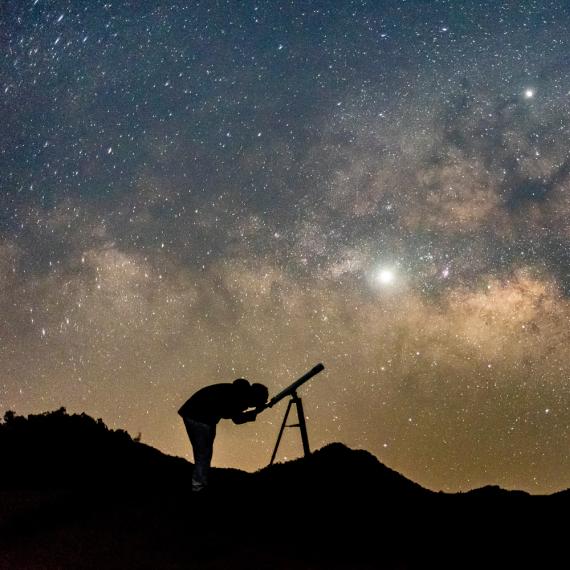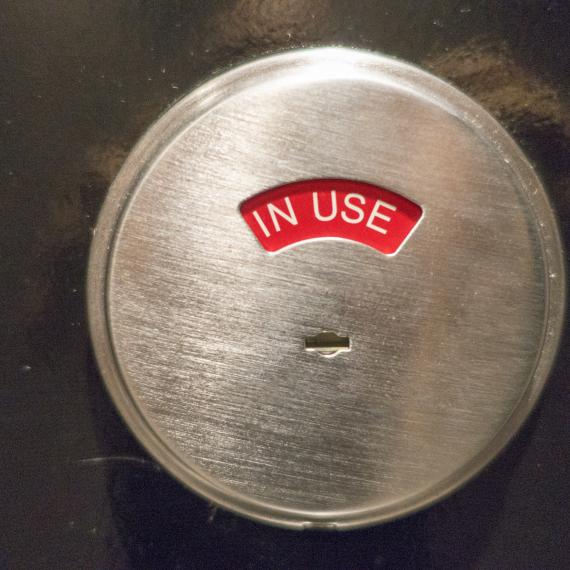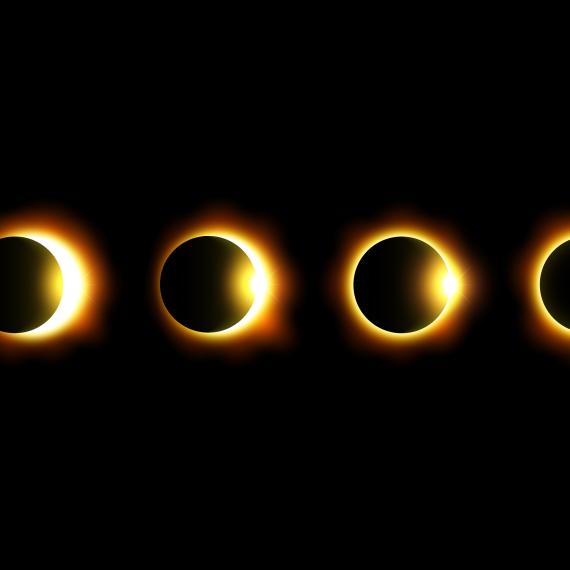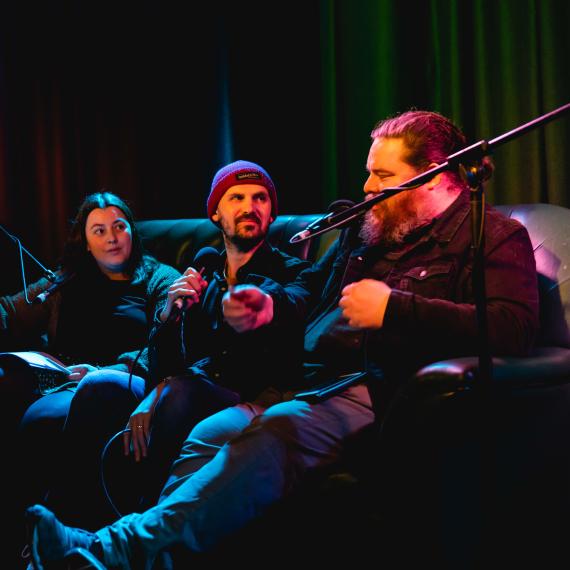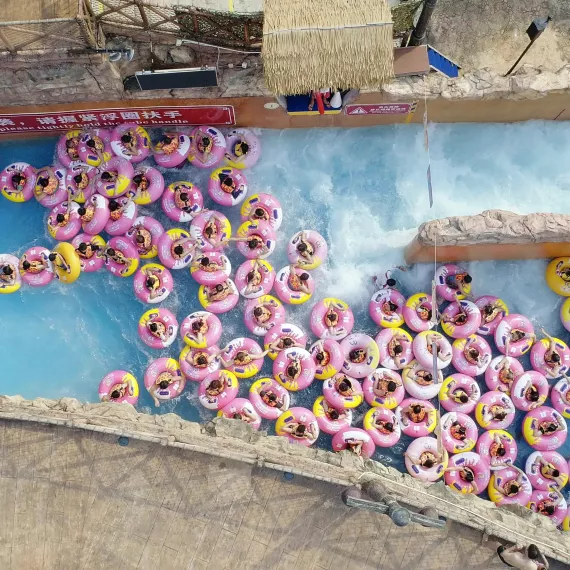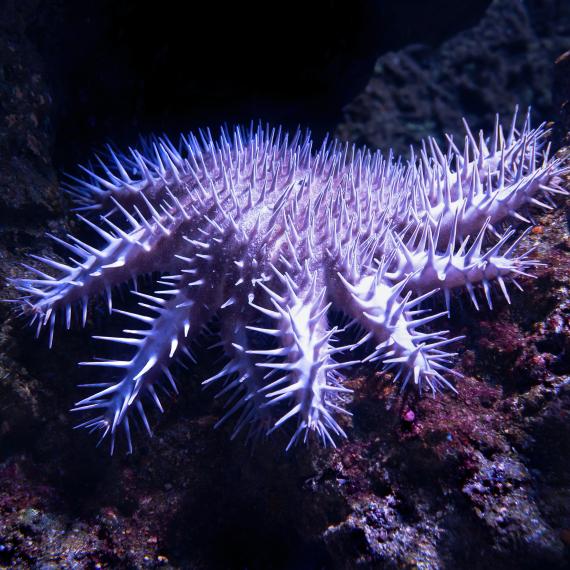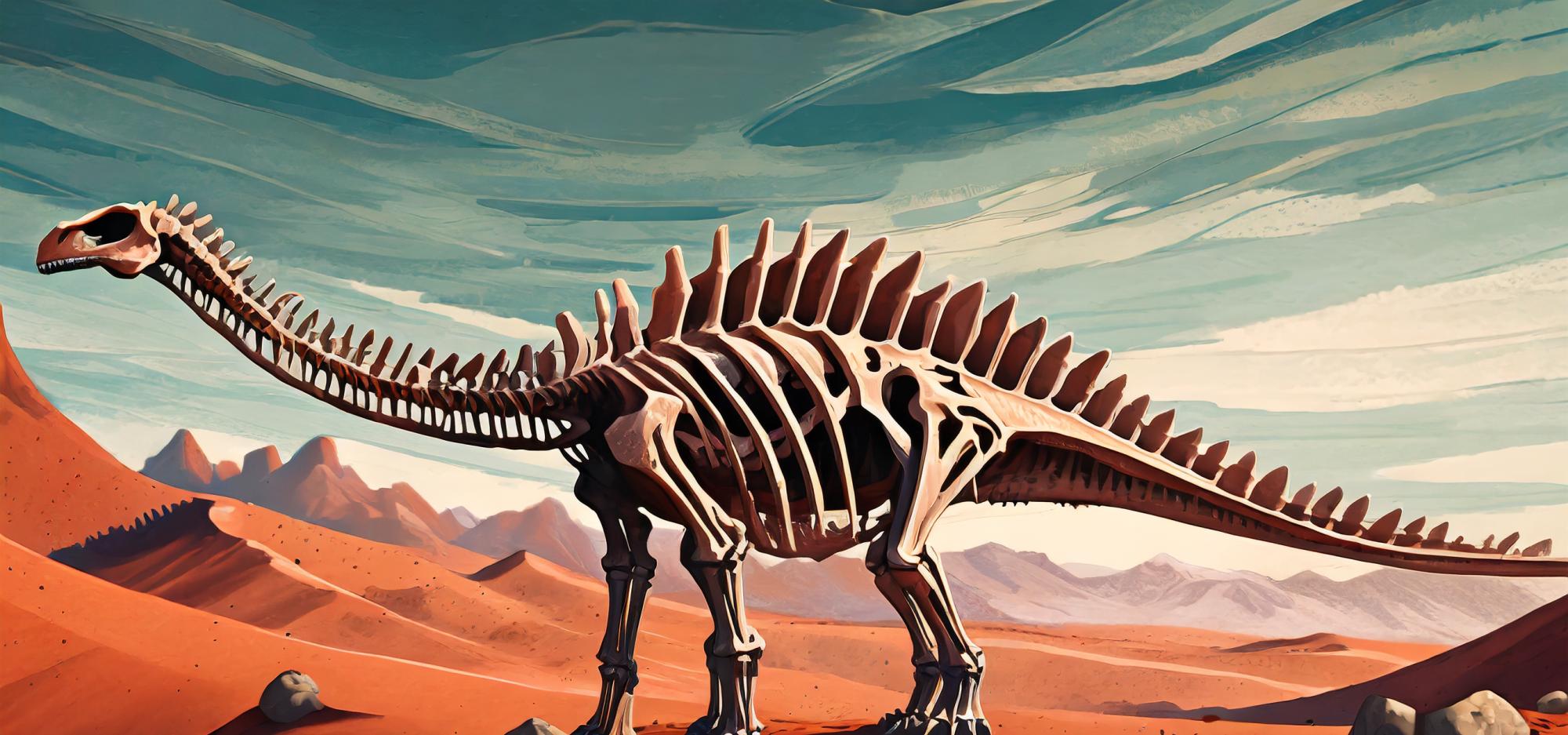
Dreaming of dinosaurs — a journey in palaeontology
Dive into the fascinating world of Australian palaeontology and journey back in time to the Cretaceous Period (145–66 million years ago).
Australia's fossil record of dinosaurs and their contemporaries has long been shrouded in mystery, but this is changing rapidly, thanks to citizen science, regional museums, and exciting discoveries. Join Dr Stephen Poropat, a research associate in palaeontology at Curtin University, as he explores the secrets hidden within the Otway and Gippsland basins of Victoria and the Eromanga Basin of Queensland.
Gain insight into the captivating science behind Australian palaeontology and explore what life was like in ancient Australia. This talk is an engaging adventure suitable for curious minds aged 8 and up.
-
Episode transcript
Intro:
Welcome to the Western Australian Museum Boola Bardip talks archive. The WA Museum Boola Bardip hosts a series of thought provoking talks and conversations, tackling big issues, questions and ideas and is delighted to be able to share these with you through the talks archive. The talks archive is recorded on Whadjuk Nyoongar Boodja. The Western Australian Museum acknowledges and respects the traditional owners of their ancestral lands, waters and skies.
Arlene Moncrieff:
It’s Meet the Museum tonight, as if you didn’t already know, we're delighted to be welcoming Dr. Stephen Poropat from the re.. as a research associate in Curtin University School of Earth and Planetary Sciences. Born and raised in Melbourne, Collingwood supporter?
Dr Stephen Poropat: No
Arlene Moncrieff: Good, that’s alright, there ya go, Stephen wanted to be a palaeontologist from the moment you could pronounce the word. High achiever, already
*Stephen and audience laughs*
Dr Stephen Poropat: I didn’t tell you the answer, I was about twelve when I could pronounce it properly
Arlene Moncrieff:
*laughs*
He's now living his childhood dream as he studies the terrible lizard. So it's an absolute delight having you here tonight, um, Stephen and I'll hand over to you. And the other thing I did forget to mention, we’ll leave the questions till the end and to be able to for people to hear your question in the audio, I will have a hand-held microphone. So if you can just wait.
Cecily, can you waive it about?
You can see it at the back, if you could just wait and then ask the question when the microphone is in front of you, that would be much appreciated. Okay. Round of applause to Stephen.
Dr Stephen Poropat: All right. Thank you for that wonderful welcome and introduction. I'd also just like to acknowledge the Whadjuk people of the Nyoongar nation, on whose land we gather tonight, and also the indigenous custodians of all the lands that the fossils that I'm talking about tonight have been collected upon in this great country of ours. So, yeah. Dreaming of dinosaurs.
Simply put. Yeah. The fact that I still get to work on dinosaurs and fossils in general is the culmination of just a dream that was a childhood one, basically. And it started with, as these things often do, and hopefully this is going to work. We'll see how it goes. It's not going too…….there it is. It started with this book.
It was I mean, I'm sure the person who wrote this book was just doing it as a job, you know, not really passionate about the dinosaurs. The illustrations are terrible. And yet this is what sparked my interest in dinosaurs. So sometimes the smallest gift — and this was from a couple of family friends that lived two doors down a given to me at about age four —still got it somewhere. Binding’s completely ruined, but that's symptomatic of a good book, I guess, at least in a five year old's eyes. This is what triggered it all for me. And from that moment I just never wanted to relent in terms of just the passion for palaeontology that I was able to develop over time. But that doesn't happen in a vacuum. I had big family support.
So my parents were really supportive of it all through school. Even when going to careers councillors like “I don't know how to advise you; study science, I guess”, but that's about as far as we can take it. There's not really a career path for palaeontology. So yeah, dinosaurs were part of the nativity at church and part of the every birthday gathering we had and all this sort of stuff, So yeah,
*clicks slide clicker*
temperamental.
*clicks slide clicker*
I've taken out one slide that I should have put in. Doesn't matter.
But of course, that was also something that was nurtured, I guess all through undergraduate in particular, where I started meeting lecturers, meeting scientists, meeting people who were actually doing palaeontology or geology as a job and finding out how to get into it, what opportunities there were as a volunteer or for research and that sort of thing.
And so you can see I've kind of stayed in Melbourne for many years, all the way from P… Bachelors to undergrad to PhD, but then moved overseas for postdocs, move back to Melbourne for another one. And now I'm here in WA and delighted to be so. Yeah, what I'm going to be talking about tonight is dinosaurs of course, but what I want to focus on, first of all, is when dinosaurs lived, and that's the Mesozoic era. And Australian Mesozoic palaeontology, there is so much we don't know still.
It's a window of time from about 252 to 66 million years ago. That's when all the non-avian, the non-bird dinosaurs go extinct at the end of the Cretaceous. Most of my research is focused on the Cretaceous forms and there's a good reason for that that I'll get into. But as you’ll see, there's, there's hopes that we'll get into some older stuff as well in time.
So just put this in perspective. When we talk about the Mesozoic, it's the middle of three eras within what we call the Phanerozoic eon. Before that, there's about four billion years of time, but there are very few recognizable animals from that time, at least ones that we can appreciate without a microscope. And so what a lot of palaeontologists focus on is everything from the Phanerozoic.
So Palaeozoic is before the dinosaurs. Mesozoic is when the dinosaurs appear, diversify, take over the earth and then go kaput. And then you get to the Cenozoic, which is what we're living in right now, the Age of Mammals and still dinosaurs, because birds are they're living descendants as well. So if we wanted to find Mesozoic rocks and therefore dinosaur bearing rocks in Australia, we need to find sedimentary rocks. So rocks that are deposited by water or by air, so windblown sand dunes and that sort of thing. We need to find those rocks exposed at the surface in Australia from between 252 and 66 million years ago. That's going to dictate where we're going to be able to actually find stuff without doing big open cut mines into older rocks that are at the surface already.
And so you can see that depending where you live, you've got a higher or lower chance of having those rocks under your feet. Where I lived in Melbourne, no chance. All the rocks are too old. They were Silurian, so there's something like 450 million years old and you wouldn't have had a chance of finding dinosaurs in them at all.
But under Perth you can see there's some hope potentially as Cretaceous rocks. Western Australia looks great, but unfortunately in the Mesozoic so far it has really delivered very little. But the thing is I think that a part of that is and this is not to diss, you know, to diss anyone who's gone before, but a lack of maybe support for collecting effort. People like John Long, Mikael Siversson, they have wanted to explore the Mesozoic in depth in this state, and yet often there are limitations of time, funding, even just field season in this part of the world, because so much of the time you go further north than Geraldton, it's just inhospitable for so much of the year. And so doing field work is just impractical. But I think that this could change, or at least I'm very hopeful that it will in the future.
What I can say also though, is that that map was a little bit misleading because while there might be a fair bit of Cretaceous in the Perth Basin, so underneath our feet. On the most recent maps from Geological Survey, it's not really as promising until you go down to where the green stuff is down near Bunbury and Margaret River and that sort of thing. So you can see there is plenty of Mesozoic rock there’s Triassic. I'll talk about that a little bit later. There's some Jurassic as well under Geraldton and that's produced, mmm…again, I won't spoil the story. Um, there’s Cretaceous as well. So we've got rocks from each of the three err…, three periods within the Mesozoic era exposed in Western Australia.
Ergo, there's a potential to find dinosaurs across quite a bit of the state. So it's a bit, it's a bit strange that we've got so little so far. So what I thought I'd do is I would I thought it would be great to go through basically just a quick timelapse through the, through the Mesozoic.
So we look at the modern day, we rewind the clock, we can put the continents back together as they were in the giant supercontinent, Pangaea. This is before the first dinosaurs. So the start of the Triassic dinosaurs aren’t around. But they ancestors have free rein. They can walk from one pole to the other unimpeded, except if they don't like deserts. And there’s still coast to get around, so that's okay. If we look at Australia's Mesozoic vertebrate record: earliest Triassic, it's great we get off to a cracking start. Tassie, Western Australia, Queensland, New South Wales, they've all got records from the first 10 million years or so of the Mesozoic, so it's brilliant. But then, I will show you one of those. These are some of the animals that were found up in up near Derby in Western Australia. So you've got Erythrobatrachus, which is this marine amphibian eating a lungfish and Deltasaurus as well. These were living at a time when they could again basically walk or swim all the way across the globe. And indeed, we find very similar forms in Antarctica, South Africa, that sort of thing. If we move forward in time, the later Triassic record is not great. There’s a bit in the Sydney Basin and a bit near Brisbane, but not much more.
And then the Jurassic is possibly even worse. We've got three dinosaur skeletons, oh, one dinosaur skeleton and two additional bones from the whole Jurassic in Australia, and that's it. And there's not much in terms of marine reptiles or anything else either. So the Jurassic is really poor in Australia. It's a big gap — and yet, Western Australia has two of those dinosaur bones. You can see them in that gallery right through there. They even get the whole Western Australian dinosaur collection would fit in a small child's shoe box. It's three bones and that's it. So again, there's plenty of potential, but it's unrealized so far. So you got Ozraptor, which is just the bottom end of a thighbone, the tibia. Sorry, not a thigh, a shinbone, a tibia. And one tail vertebra that's been attributed to a long-necked sauropod dinosaur. Although, now that I've seen it, it's so small. I'm like, maybe it could be something else. Or it's a baby. So who knows?
Then we move into the earliest Cretaceous, and this is where Western Australia really sort of comes to the fore when you go up to Broome, you get this period of time that is otherwise unrepresented by vertebrate fossils in Australia. You get the wonderful footprints near Broome and Walmadany and that sort of area. And so you have this incredible diversity of animals, but they're all represented by footprints and nothing more. Not a single bone has been found in that part of the country so far. So all the evidence that any interpretation of the dinosaur fauna has relied on, is the tracks and nothing more. So again, it'd be interesting to see if bones could be found in that area. There's plenty of rock. It's just a matter of getting the tides right and everything.
So we'll keep moving forward through time because Western Australia's still got a little bit to say, but this is where Victoria in particular, but also South, er, South Australia, New South Wales, Queensland, they all come to the fore in the early, uhh, late, early Cretaceous.
So this is a period between about 125 to 100 million years ago and pretty much most of the dinosaurs you would have ever heard of from Australia. If you know many of them, many people might not. They would become from this time window because this is the best studied. There are most rocks at the surface that we can target across huge swathes of the continent, and that's because of this.
You can see Australia down here. It's been inundated by an inland sea and this is called the Eromanga Sea. It varied in extent throughout its 50 million year existence, possibly completely receded, leaving dry land behind it quite a few times during its existence. But because of this you have Cretaceous sediments across quite large swathes of the continent and it's thought that with the existence of this ancient sea, all the explorers who are thinking that we're going to find an inland sea in the centre of Australia, 100 million years too late. There was one. All the evidence pointed to it, but it had been gone for a very long time. And you can see again, we put that map next to the map from the middle section where you basically have Australia becoming a series of islands and you can start to see why a lot of these rocks exist. They represent the path of that ancient seaway.
Now of course being a seaway, dinosaurs weren’t marine. We sometimes we find their remains washed into the sea, but that's very rare. We find more marine reptiles across the extent of a lot of it, and yet still the dinosaurs, even though they are rare, they're still important. By the time you get to about 105 million years ago, the Sea's starting to recede and that's when Queensland and New South Wales come to the fore and provide us with a wonderful insight through the opalised fossils at Lightning Ridge and then the magnificent fossils around Winton in central Queensland. And that's one of the areas that I'll be talking about tonight because it's been my bread and butter for the last ten years and that is the last sort of 5 million or the first 5 million years of the late Cretaceous.
You probably notice Cretaceous ends and 66 million years ago, what happened to the last 30 million years? Well, I'll get into that. So Late Cretaceous, you’ve started to see Australia becoming basically one continent again, not broken up by seaway, and that's when we get one deposit in Gingin, the Gingin Chalk, where you get evidence of pterosaurs — not dinosaurs, but close relatives — marine reptiles like a mosasaur, and one theropod bone as well. So I lied, there are, there are three, that is the third one bone from Western Australia. Then the late Cretaceous, the last 30 million years are again this gap in our knowledge. We just have no idea what was going on throughout much of Australia for a whole time bin. There's one deposit in Western Australia called the Miria Marl, which produced two bones so far, one that was thought to be a theropod dinosaur, a meat eater, but it's actually turned out to be a turtle. The other, which is part of one of these giant pterosaurs called azhdarchids. So they were toothless, basically living like big albatrosses. Some had wingspans of 12 to 15 meters. These were massive, the largest flying animals of all time. We've got one in WA. So, the thing is, I'm interested in dinosaurs. You guys are here to hear about dinosaurs. I'm giving you sort of the context for what I'm going to be talking about.
There are three groups of dinosaurs primarily that interest me at the moment. One that I'm really actively studying, as you see, one that I'm somewhat less actively studying and one that I've given to a student because he can do it much more expediently than I can, even though I know the group well. He's got a lot of little bones to deal with in a little time, so we'll go through them quickly.
So theropods, if you don't know what they are, any meat eating dinosaur that you've ever seen depicted, any bird that you've ever seen, that's a theropod. Umm, most of them, uh, they're all bipedal, maybe Spinosaurus was an exception. And you can see that they're primitively anyway, they're predatory and you can see that they also vary quite a bit in terms of their relative proportions, some have long neckz, some have short necks, some have huge heads, big teeth, others have got longer arms and they're just massively variable as predators often have to be to be on top of their prey.
The other groups, the ornithopods, they're a little bit more predictable — until you get into the very end of the Cretaceous with a hadrosaur start to go nuts with all their headgear. But these are plant eating dinosaurs, they stay small or relatively small for most of the dinosaur era. And then in the Late Cretaceous, they actually start getting almost as big as sauropods, or at least as heavy. Never as long.
And last but not least, the best, because, well, sauropods – they’re the biggest animals of all time on land that the ones that I've studied most intensively for the last ten years and I, I mean, I've just always found them to be the most interesting. How could something this big — you know, 30 to 40 meters, 60 to 80 tons — how could it get around? How could it sustain itself? Those are the sorts of questions I've always wanted to answer.
So we'll go through those sauropods quickly. All three of those groups were around in the Early to Middle Jurassic, so that meant they were around when the Earth looked like this and they could get all around the planet. But as their existence went on, the continents became more and more fragmented and that had a big impact on their distribution across the globe, and on which groups actually lived where. And as an example of that, think big horned dinosaurs like Triceratops or Styracosaurus in North America, Eastern, Sou… Eastern Asia, that's it. You don't see them anywhere else. And that's because by the time that group actually appears, the continents are so fragmented that they really can't get anywhere beyond that sort of origination point. Um, for these guys, it's very different.
So we’ll start in Victoria, I'm going to go through Victoria relatively quickly. I go through lots of slides in a very short time and I apologize if it's somewhat epileptic fit-inducing. But yeah, that's I've got to, I've got to work on the number of slides I think in future.
The Victorian record is largely comprised of fragmented fossils, so you just find one bone isolated in a flood deposit or a river deposit. Very rarely do you find partial skeletons. And so that means that you have to intensively study single bones to actually come up with any sort of story from a lot of the Victorian record. All of the fossils from Victoria, barring one or two sites, have been — actually, no, three or four sites — have been found along the coast. And so you can see all of these units that I'm pointing to, all these deposits that I'm pointing to, these are coastal. And that’s because fresh exposures of these rocks are really hard to find in land. You can see on Cape Otway, it’s forest or farmland. Down the Bass Coast, same deal. And so getting access to fresh rocks is really hard unless you go into where the waves are, cutting the platform repeatedly through through time. And so all the digging that gets done in this part of the world happens on the beach. Often the biggest obstacle to finding the rocks is just digging up lots of sand, getting down to the layer and then using sledgehammers, rock saws, whatever tools are available to break into the rock and then expose bones that are softer than the rock itself.
So this is what people end up doing. They end up digging big holes, pulling out chunks of rock, and then that rock is reduced into often sort of sugar cube-sized pieces because one of the big targets for this particular program, which is called Dinosaur Dreaming — it's a misnomer. They're looking for mammals and they're looking for mammals whose jaws are about this long. So they go sugar cube size so that when they break it in half, they're not going to miss very many of those mammal jaws. Of course, the dinosaurs are found as a bit of a byproduct of that, but they're still they're more commonly found then the mammals because, well, they're just more abundant at that time and easily more easily fossilized as well.
So this is probably one of the most impressive remains of a theropod that's come from Victoria. And I actually have a 3D print of that one here to show you the approximate scale. This is the hand claw of a therapod dinosaur called a megaraptorid. So this would have been on the thumb of the animal, and in life it probably would have been another third long when it had its keratin sheath. Now that looks pretty dangerous. You wouldn't want an animal like this coming towards you in a dark alley late at night. However, I'd argue that this is worse, and I actually have a cast of this claw in my on the left photo as well. That's Megaraptor itself. Same claw, same digit. Imagine that with another third of keratin on top of it. This is a beast compared to this. There's about a 30-million-year age gap between these two animals. But more telling, this is from Argentina, this is from Australia. So this is telling us that these animals could get across Antarctica between those continents and proliferate either side of what was becoming the Indian Ocean. And so, yeah, to see something like that, to see tangible evidence of that connectivity between the continents, that was something I was always hopeful because we wanted to understand how these animals were moving from continent to continent through time. I'll leave these up here at the end. Feel free to come up and have a look, and they're all perfectly handable, handleable as well.
So this is what a Megaraptor would look like. Think T-Rex, You got a… that's a head-first predator, tiny arms, massive teeth, big head, reinforced neck, head-first predator, things like the Velociraptors and Deinonychus, they're foot first predators. They're using their claws to attack prey. Megaraptorids, they're giving you a big hug. They don't, you know, you often see the bunny hands in the Jurassic Park therapods. They're not like that. They clapping rather than bunny hopping. So they're giving you a big hug, digging those claws in and not letting go. And I think that probably would have been really helpful targeting small ornithopod dinosaurs like the one you can see here because they're small, they're squirmy, they're manoeuvrable. It's not going to go off and give a sauropod a hug because it's not even get around its legs. So I think they're probably smallish prey specialists until they get to Megaraptor size when they can start being a bit more adventurous.
Now another bone which is far smaller but turned out to be possibly far more significant. This one here, it was found by a girl called Jessica Parker, who was volunteering for Dinosaur Dreaming. And for a long time after this bone was prepared, it was thought to be from a pterosaur, a sort of flying reptile. My PhD student, Adele Pentland, studied this bone several times and eventually worked out that it wasn't a pterosaur and that set us going, What is it? What could it possibly be? We realized that it was actually, ahh the 3D video is going to work today so there you go. So it shows that much larger than it actually is. This is life size. What it is, is the neck vertebra from what we call an elaphrosaurinetheropod. And when we were studying it, we realized that probably, possibly one of the reasons it wasn't recognized for what it was is because Elaphrosarus, which is the one you can see on the left that lived about 40 / 50 million years prior to this animal, and that group was thought to be extinct at the end of the Jurassic when we were working on this specimen. So we were thinking it's like finding a, you know, a rabbit in the Precambrian. It's just not going to happen — it’s so far out of its time. But this is from Tanzania. So again, we're looking at this sort of evolving picture of the continents shifting position and dinosaurs changing with that. It was perfectly reasonable for it to be an elaphrosaurine and we demonstrated it pretty unequivocally. No one's contested it in the last three years. We'll see how it goes in the future, but this is possibly what it would have look like in life. And we can reconstruct that mainly because of a Elaphrosaurus itself, but also a couple of relatives from China and and from Argentina.
But as we were trying to publish this paper, it actually turned out that they found one that was even younger geologically. So something like 60 million years younger than Elaphrosaurus in Argentina. But very g… within two weeks, I think, these two papers came out and all of a sudden elaphrosaurines were in the Cretaceous throughout South America and Australia. And so it just showed how one bone from each side of the world could change the story of how these groups, how this group had actually evolved and we're hoping, of course, to find more evidence of this because it's small, it's meagre, but it's pretty unequivocal and, you know, we even had some world experts on theropods look at the bone and say, Yep, it's almost certainly got to be that. So yeah, it'll be nice to validate it further with future fossils. But well, as Tom Rich would say, the best fossil is the one you have. So we’ll take that.
Let's move on.
So this, this sort of re, reiterates the point you've got elaphrosaurs are world wide in the late Jurassic because of Limusaurus up in in China. But it's perfectly reasonable to think that these animals were across the whole Southern Hemisphere at that time. And by the time you get into the Cretaceous, when you’ve got our little Victorian one and then Huinculsaurus in Argentina, there’s still a bit of a connection between South America and Afri… er, and Antarctica. It doesn't sever properly, like full until about 50 or ff…no.. 40 to 30 million years ago when you get the Drake Passage opening and so it's perfectly reasonable to think these guys basically island hopping across that little bit of ocean and getting between South America and Antarctica at that time. So just bear that map in mind because it might come up again a little later.
Now we're going to shift away from the theropods. Sorry for anyone who's a big theropod fan, but we're going to go into the ornithopods now. This is from the same site. This is one of the very few articulated skeletons from Victoria of a dinosaur. There are only four. I'll show you them all quickly. This is one called Diluvicursor. It's just a tail and a back foot. If we move to …… we can see that there are jaws from the same site. This shows you the scale of an ornithopod jaw. That's just the maxilla from the upper jaw. So the whole head probably would have been right back to there to the jaw hinge and there would have been a little beak at the front. So these are pretty small animals, they’re like the wallabies or the kangaroos of, of their age, but they're not furry and they're not hopping around. But some of the more spectacular ornithopods in Victoria came from Dinosaur Cove and this is a site where instead of digging in the sand, they were basically tunnelling into a cliff using dynamite to actually make a hole in the cliff and target a fossil layer for something like ten years and then hauling all the equipment out and in day to day, because of the tides coming in and often being quite rough. These labours yielded some amazing fossils, including Leaellynasaura, which is represented by the side of the skull and the roof of the skull there. But there were also two partial skeletons that came out of that deposit as well, out of Dinosaur Cove. One of them has this super long tail, something like 74 vertebrae, probably the longest tail known for an ornithopod anywhere. The other one miss… the tail is missing, but both of them preserve hind limbs. Both of them preserve parts of their hips so they can be compared with that Diluvicursor specimen which had the tail and the back foot.
The fourth skeleton comes from a different site. I'll show you some beautiful pictures from Peter Trusler of these dinosaurs. But the fourth specimen comes from near Flat Rocks, which is a site that again had been targeted for something like 20 years. They've found about 50 mammal jaws there, but then hundreds of dinosaur bones as well. And some of them became new species. They have Qantassaurus and Galleonosaurus known from jawbones, and then five, about 200 meters away from this site. And at one place called Noddy land, they found this wonderful fossil … no next slide…. called Noddy. And what you can see here, this is what my colleague Laura Porro has been able to do with some scan data. So this fossil was taken to the synchrotron in Melbourne. It's scanned with a giant X-ray machine, essentially a giant particle accelerator, and she was able to separate part of the skeleton out of the rock without doing any destructive ahh…. destructive analysis of it at all. But what can you see? She could do the head. She can do the first part of the neck, but there's more of that specimen to work on, and we've actually got the head, the entire neck, and then the first seven vertebrae from the torso as well. All in place. All the ribs are there, the shoulder blades on one side as well. And it even seems to preserve its last meal. So this is one project that I'm currently working on. Basically, it's one that I'm hoping to get done before Tom Rich and Pat Rich have to bow out because they are retiring soon and I would love to get them to get this publication out too, to work with them.
But this specimen is superb. It’s only about this long, and we were hoping when it was found that it would be kind of a Rosetta Stone for all those other ones, but unfortunately it doesn’t preserve anything behind the torso, so it can’t be compared with any of them. And you can see that that jaw, the jawbone at the front, the maxilla, there’s very little of it left. And so it can't really be compared much with jawbones like this. So comparing it against all the name species in Victoria except Leaellynasaura is almost impossible, which is really unfortunate. Means we can't say for sure its a new species — it might be one we already know, but we have to wait for fossils additional to this to determine that.
And one thing that I want to do with that specimen is compare rigorously against, against, the Argentinean specimens of ornithopods. This is one called Macrogryphosaurus. It has a super long neck. So I don't know if anyone knows what a gerenukis, a type of long necked antelope they often stand up on their hind limbs, reach up really high in trees to get even higher. Macrogryphosaurus is like an ornithopod trying to be a gerenuk. I think it's sort of high browsing using its really elongate neck to do that. And something like 30 million years later you've got Talenkauen, close relative, basically doing the same thing. And hot off the press, there was a new Talenkauen specimen announced yesterday, which has got an even better skull than the original. So there's plenty of material in Argentina to compare Noddy against. It's just a matter now of doing the research which would take a bit of time.
And Gasparinisaura for good measure. This is a skull. It's about that long, so not far off Noddy’s size. It's a juvenile ornithopod from about 40, 50 million years after Noddy, again living in Argentina. It's kind of a weird juxtaposition, all the fossils in this animal were found within a kilometre of a modern day human graveyard. And all those ones were collected basically by crocodiles, ripping them out, you know, coming to the shore, snatching them in. You find crush marks on their bones, you find its snouts missing. Goodness knows what happened to it before it died. Poor thing.
Anyway, we now move into Winton, which has been the main focus of my research for something like the last 10… 10 to 12 years. This is what it looks like today. Really flat, quite arid, grass and eucalyptus trees, really scrubby forest. If there's anything you can even call forest only on the creeks normally. But this is where we're finding a lot of dinosaurs in Australia at the moment, mainly because of the Australian Age of Dinosaurs Museum, which I've been working with since 2011.
And this museum was founded basically by people who didn't want Winton to die because they were seeing towns in this area just dwindle in terms of population, as, you know, farmers.. farms started needing fewer workers as just industries started dwindling. And so David and Judy Elliott… I’ll show you in the next one, I’ll go there…. They founded this museum in 2002, ran it out of their farm for seven years, then acquired a site, started building a museum, and they've just continued to grow it ever since. And it's been a privilege to work with them, especially Judy, because she is, if there was a jigsaw puzzle competition anywhere in the world, she'd win it. She's just amazing in terms of how she can put fragments of bone together and come up with the whole. But so what they basically do is they all encounter a site. Which’ll just have a few fragments of bone at the surface, they'll get people to sweep along, find whatever bits of bone they can, and then they'll bring in the heavy earth-moving equipment. A front-end loader, an excavator, they'll strip off the topsoil and they'll get down below that to less weathered, less destroyed or less eroded, I guess, deposit. This has been the thing that held back Queensland palaeontology for a long time in terms of dinosaurs: that topsoil is really hard to get through with tools, and yet it's about a meter deep, and so you had to be really dedicated to get through it. Very few people bothered unless they used earth moving equipment and when they started using it routinely, all of a sudden they were finding sites every single year and they now have more sites than they even know how to find the time to dig. So it’s an amazing change and it’s been a privilege to be part of it. But I mean, I feel like I was riding a wave. They were already established as a museum before I even joined them. So I’m just thankful I’ve been able to be involved at all.
One of their most famous discoveries was two dinosaurs buried with each other. So what they call Matilda and Banjo or Diamantinasaurus matildae and Australovenator wintonensis. All the bones in yellow, they’re the better bones because they’re from a sauropod. So, you know. So yeah,
Audience:
*laughs*
Dr Stephen Poropat:
That’s Diamantinasaurus. All the bones in red are bones from Australovenator. So these dinosaurs definitely lived at the same time, whether or not they had any sort of interaction with each other before they died, who knows? Some people speculate that Australavenator was scavenging Diamantinasaurus and then got bogged himself after Diamantinasaurus did.
I should say. We know that because that's one front foot. The other front foot was right there. So this animal's gone front first into the mud, the feet have penetrated really deeply into the site. It hasn't been able to get it out. And so then it's gotten bogged and been scavenged after that. And this is typical of Winton sites. We don't often find bones all in nice rows showing, say, a whole tail, a whole neck or anything like that. So still spectacular to get that many bones all from one animal. So this was the picture of Diamantinasaurus when I started working with the museum back in 2011. And over time we've actually been able to fill this out quite a bit, as I'll show you.
One of the reasons for that is because of a dinosaur nicknamed Ann. Ann, you might have heard about it earlier this year because the paper came out. This was fantastic to finally get it out there. And I mean, when I talk about childhood dreams, finding this specimen pretty much fulfilled one of my ones, and I'll let you know what that is in a moment. You can see that it was a site that was essentially split into two parts. You had bits of the back of the body and then more bits of the back of the body, but with something else as well. Those from the back of the body were great: we could compare them with the original Diamantinasaurus specimen, bone for bone identical. No doubt it's a Diamantinasaurus in our mind. So you can see there's the original thighbone. This one even has the same ridges going down the front. It's basically identical. And so we had no doubt that it's the Diamantinasaurus, but it was what was preserved at the other end — there's the back foot compared to a whole bunch of other sauropod back feet, if you like feet; I like sauropod feet! — so you know, but if we go down the other end of the animal we start seeing a whole lot of little, little bones. And this was really bizarre. We started seeing weird shapes and sizes and we're thinking these all look like they kind of go together, but they could just be the ribs of the neck or something like that.
Turned out that they all went back together to form a skull from a sauropod, and this was the first reasonably complete sauropods ever found in Australia. So to find that like that was literally one of my childhood dreams; when I realized how poor the sauropod record was in Australia, if we could find a skull that would be outstanding. I got to describe a less complete one back in 2016, but this one just surpassed any expectation that we reasonably could have had. I brought a few 3D prints which actually were made by Matthieu [Cobby Cagnon]. Thank you very much for that, in the crowd. So he printed these out for us, life size and so you can see these are the tooth bearing bones of this animal. So that's the upper jaw, the lower jaw, the whole jaw would have been another half as long, again, because they've got more bones behind this one. But all the teeth would have been in here when you can't see them because they're all busted out as a result of possibly this animal getting trampled or scavenged after it died. And there's one other print that I brought in, which is this. That's the braincase. So this is a 14 meter long animal, thereabouts. Its brain is smaller than my fist, and yet it could still do everything it needed to. So, you know, they were, they were around for 130 million years. I don't think they were doing too much wrong. So, yeah, you don't need brains to win, maybe, but I guess humans play a different game.
So that's Ann’s skull, what you can see, this is how we reconstructed it. We basically were able to mirror image bones that we only had on the left side or the right side, put it all together and actually come up with an idea of what the whole skull looked like. And this was really important because with sauropods, often the skull shape can tell you a little bit about what they might have been eating, and I'll get into that a little bit later.
But this is what we thought Ann might have looked like based on that skull. This might change again of course, if we find a better skull that shows some of our interpretations were wrong, but it's probably not too far off the mark. And you can see here it compared with a skull of an Argentinean sauropod called Sarmientosaurus. This is a skull that I've been to the museum where it's hosted twice and not been able to see it. So at some point I'll get over to Argentina and I'd love to see it in person, but bone for bone, it's very, very similar to Diamantinasaurus. It’s living almost at exactly the same time in the southern part of Argentina. So again, it's showing us that there's probably connectivity between these continents. These sauropods are able to walk all the way from one place to the other and probably following a similar path to those elaphrosaurines. And so hence why I said you should remember that map from before.
Now, when I was getting on about diet, sauropods tend to have either rounded snouts or they tend to have squared off snouts and Nigersaurus is just doing its own thing. It's ridiculous. But even things like Diplodocus and Apatosaurus, they've got kind of squared off snouts. And that is something that in modern day mammals, if they've got squared off snouts, they tend to be browsing low to the ground, are snipping with their teeth and just, you know, feeding low to the ground, possibly getting grit on their teeth as well. Those sorts of sauropods also tend to have really narrow teeth that they replace really rapidly. And that means that, you know, again, if they're getting grit in their teeth, doesn't matter. They can just knock the tooth and replace it. It's all good. Diamantinasaurus doesn't fit that low browsing model based on this skull. We're seeing a more rounded snout, it's a bit deformed. Like you can see this jaw. It probably should actually be a bit more curved than it is. It's been flattened a bit, but it's not going to be 90 degrees to this angle, not like this absolute weirdo called Antarctosaurus from Argentina, not Antarctica. So yeah, that's, that's taking low browsing to extremes in a titanosaur. So a dino.. a sauropod closely related to Diamantinasaurus. So what we would be able to infer from just the skull shape is that it's probably not a specialist low browser. It's probably feeding at least a metre, but probably higher off the ground. And we were able to then look inside this skull because as I mentioned, we can't see any teeth on these bones. We know they should have been there to sauropod. None of them had no teeth as far as we know. And sure enough, when we scan these bones at a CT scanner, we were able to see some of those teeth inside. Umm. So this is this bone right here, and this is the scan data on the right, just a video through and basically slicing through, it is just zooming through the bone. And you can see those teeth there. One… all in there, all the really white parts where it's really dense. So we knew that there were five teeth inside that jawbone and we could then separate them out in the computer to show you what they look like. So that's them there. And then we can compare them with other teeth that we'd found in the same rock unit, this, the Winton Formation, and we were able to then use those to say, well, those teeth don't show much evidence of having been rubbing against grit. So again, evidence that this is not a specialist low browsing sauropod. So the skull shape basically confirmed that idea we published the teeth first, then we published the skull. So that was nice to sort of get the confirmatory evidence while we were actually in the process of writing one paper. But then it still doesn't answer the question. I mean we’re sure Diamantinasaurus is feeding off the ground. But what is it eating? I mean, we can presume it's plants. Everyone pretty much accepts that sauropods ate plants. But the fact is we've never had a smoking gun. We've never had gut contents for a sauropod found anywhere in the world. And so that would be pretty much the proof if we could get it anywhere.
So the good thing is another Diamantinasaurus, which is nicknamed Judy, might answer exactly that question of at least one sauropod as its last meal. Judy was. I mean, look, if Ann was a dream come true, this was a dream I never expected that somehow came true because unlike that Diamantinasaurus specimen or even Judy.. uh.. Ann herself that I showed you before, Judy, was just bizarre for the Winton Formation. We found so much of this animal in place, basically. So what you see here, you've got the almost well, not even the whole neck there are two vertebrae missing at the front. There are another three that should be here. But all of those are preserved in a row. Through here, there were seven vertebrae from the torso, some of them preserved just like a couplet, two here, two there, one in the middle. They were almost in life position. It was amazing. And then we had the pelvis here. We had the left hind, uh, hind limb over here to the left forelimb here. This was, you know, about as close to a dinosaur laid out as if it was still alive as we can probably ever hope to get in the Winton formation. So to find this was unbelievable. And I’ll quickly run through the bits of bones that we got because we’ve got a jaw with teeth. We have some isolated teeth as well, so we can check these teeth independently of all those other ones that we showed you before to check what this was eating. We can see if there any wear marks from grit or anything like that. We have, other than those first two vertebrae in the neck, the rest of the neck. And so we can say the whole neck is about what must be… to that TV to about here, four and a half meters or thereabouts, and that's for about a fourteen meter long sauropod. So it's… yeah…. in the scheme of things it's a short neck because the longest sauropod necks are 11 to 12 meters long. So you know, imagine that—it's wild, compared to this one which is still long for a for a big animal. We got… this shows you the neck underneath. What you can see here. These are bundles of cervical ribs. But what they actually are tendons that have been fortified with bone and so that probably means that the flexibility of this neck side-to-side is kind of limited. But up and down, no problem. It's basically, they’re basically bracing the underside of the neck and meaning It doesn't need to use as much muscle power just to keep his neck out horizontal in front of it.
This is how we got the neck out of the ground. Essentially, it's, er, great to work with farmers because they have practical solutions to everything. Bob Elliott, Harry Elliott, so David Elliott’s sons. They rigged up this fantastic plaster jacket. They welded a rebar frame around it so it wouldn't twist, it wouldn't sag in the middle, and it was able then to be lifted, the whole neck lifted and brought into the lab and worked on in place. And it's still there. They're working on flipping it at the moment and preparing the other side. But it's it's spectacular. And then those other jackets nearby revealed the whole torso. So all the vertebrae, we basically have all the vertebrae in front of the tail. So yeah, we wish we had the tail as well, but sadly it was gone. And we can then look at those all lined up with Adele Pentland, er, PhD student there for scale. So the torso of this animal was about two and a half meters. So you've got a four and a half made a neck, two and a half meter torso, and then we actually have bits from the pelvis as well. So that's another 80 centimetres thereabouts. So already you're looking at a pretty sizable animal. But again, the longest sauropods of 50 meters almost, so yeah.. small bickies… doesn’t matter big for us. So that's great. And then we got lots of bones from the limbs and the shoulder girdles, the pelvic girdles. Ummm. These are the limb bones here compared with another Diamantinasaurus specimen and the back leg there, again showing there’s pretty much no doubt. I mean, it looks a bit weird up here, but that’s because there’s a bit that’s broken. If you take that out, you can basically put those profiles 1 to 1. They’re more or less identical. And so, again, we’re pretty sure we’ve got a Diamantinasaurus, and we can therefore fill in quite a few gaps in the anatomy, which is really exciting.
And I’ll show you that because the next slide should show our knowledge of Diamantinasaurus before Judy, which is you’ve got Matilda which is great, you know, lots of limb bones, quite a lot of ribs, a few vertebrae. You have another one called Alex, which actually has those first two vertebrae at the start of the neck and the braincase. You have a juvenile, Oliver, and then you’ve got Ann there, which is so crazy that we've got the skull and then nothing else until you get to the back legs. But whatever. Judy just blows them all the way. Like, we've got so much of her, she fills in so many gaps in our knowledge. I say her, I don't we don't know what sex she was. We never will. We're very unlikely, but we just give them all nicknames because it's better than saying AODF 888. Who’s going to remember that? You'll remember Judy. But yeah, so basically, between all these skeletons, we can now come up with this for Diamantinasaurus. So it's just wild compared to what we originally had from that Matilda specimen alone. And this is the sort of thing that enables you to compare this animal against sauropods from all over the world, from all through their history, and actually come up with a really solid idea of where they sit on the family tree—when they got there, how they got there, that sort of thing—can come from really complete anatomical information like this.
But Judy had something even more exciting going for her than being anatomically complete, and that is this little patch in the middle. So as I mentioned, we had quite a bit of the torso here. These vertebrae actually turned out to be the ones that should be plonked in there. And then that pelvic and sacral section is in there right in the guts, literally were what we think are the guts of this animal. And you can see them in the field here. They really didn't look like much to our eyes. We just thought, okay, it's a weird bit of rock that's just here full of plant matter. What's going on? Why? Why? Why is it there? Why is it nowhere else? And as I'll show you at the very end, it didn't twig for us until quite a while later exactly what we were dealing with. But what we've done is we've taken several bits of this gut contents—or possible gut contents—again to the Synchrotron in Melbourne and also to the neutron tomographer in Sydney as well. And you can see this is one chunk. So what we're looking at, uhhh, it's a ten centimetres scale, we're looking at about a A4 for that piece there. This is what you can see when you scan that specimen. If it will work. So lots, all those dark patches in there, those are fragments of plants. And we're pretty confident that quite a few of them, especially close to the bottom layer within that are the last meal of this sauropod or maybe for the last several meals on it before it died.
We've taken certain bits of it to a micro CT scanner at CSIRO as well. So this is a size, this is a piece smaller than my fist and this is high resolution. You can see everything dark in there, every little dark shape is a plant fossil or a void where a plant fossil once was. So again, we've we're seeing in pretty high detail what this animal’s last meal was. And you can see there are some bits that are going through the entire thing. These are sizable chunks of plant. Sauropods didn't chew their food, so this would actually match our expectations. We want to find—oh um, we don’t want, in science—we expect to find large chunks of plants and that we don't expect to find tiny little chewed up bits because these guys let their gut microbes do most of the work. So the thing that demonstrated to us pretty much once of, well, once and for all, we haven't published yet—so patent pending!—that we think we've got gut contents is on the downside. We found this, this is skin. So we basically have gut contents, right against skin. The skins, the scales are pointing down towards the ground and then the contents are basically sitting on top.
Now that I'm working at the Western Australian Organic and Isotope Geochemistry Centre with Kliti Grice and others, we are hoping to establish exactly how that process worked, how those, you know, the gut contents essentially enabled the skin to be preserved because sauropod skin is really rare on a word's world scale. It's probably the depositional conditions that dictated a lot of the time. But in this case it seems to have been the actual gut contents themselves that have led to their own preservation as well as the skin. And that's something that we really want to understand, whether it's something to do with what this guy was eating as its last meal, what its gut microbes were doing, or some aspect of the chemistry of the area. We want to work it out. And so that's where my research is currently going.
So as far as, you know, what the future holds, Judy and Noddy are definitely my big priorities. Judy, possibly more so, although I've got to talk about Noddy at a conference in about six weeks, so I'll definitely be doing some work on that. But yeah, most of the next three and a half to four years I'll be working on exceptional fossilization. So not just dinosaurs, I’ll be working on all sorts of fossilized animals, all sorts of fossilized organisms, and anything basically from any age. And that's because the big focus for Kliti’s group is basically tracking biomolecules, so organic molecules through the fossil record and what they can tell us about how life evolved, how extinction events have impacted organisms over time, and basically filling in a lot of the picture that you just can't get from studying the fossils from the outside alone. That said, in addition to doing that, I would love to get into the Triassic, the Jurassic, and Western Australia actually has some areas where that is possibly, you know, a reality. And so I'd love to get into that. But you know, for the time being, there's plenty of stuff in the Cretaceous for me, so I might just stay in my lane until for the time being.
That's it for me. But yeah, feel free, please, to ask any questions you like and thank you so much for coming.
Audience:
*Applause*
Arlene Moncrieff:
I have the magic wand. If you have a question just give us a wriggle of your hand
Audience member 1:
I was in Winton a year ago and I spent a week in the fossil prep lab and I want to go back there but its just too much of a mission. Is there any chance for me to volunteer to do fossil prepping in WA?
Dr Stephen Poropat:
I'm honestly not sure I know the people I can ask, and if you give me your email address or something like that, I can certainly find out. But I mean, as you might have seen in the news in the last few days, they've recently found quite a few Diprotodons up north. And I imagine if those specimens come here, that will need somebody to work on them and so there might be opportunities at the museum to do exactly that. Yeah. Again….
Audience member 1:
Are they very fossilised?
Dr Stephen Poropat:
Beg your pardon?
Audience member 1:
Are they very fossilised? *spoken louder to be heard better*
Dr Stephen Poropat:
They are, yeah, So they'd be under 2 million years old, preserved in a river bank. Um, but they, I don't know how hard the rock is around them, but irrespective of that they'll want to expose the fossils properly and they might need more people than they have available to do that work. So it's definitely worth asking.
Audience member 2:
I was just wondering what your PhD thesis was about?
Dr Stephen Poropat:
Yeah, good question. It was not about dinosaurs. So I guess like what my path should be indicative of is that it's not a straight one. I could have probably, you know, if I'd wanted to go overseas or something like that, I could have gone and studied dinosaurs somewhere else in Australia. There were no options when I'd finished undergrad, so I pretty much thought, Well, what's going to give me a job?
And I knew that if I studied microfossils—so fossils you have to look at under a microscope like ostracods, which are tiny little crustaceans, or forams [foraminiferans], which are little plankton—that I would probably be able to get a job in hydrocarbons industry. When I did my Ph.D., I did ostracods. So I was basically tracking how ostracods changed through time in the South Atlantic Ocean, well before it was the South Atlantic Ocean. It used to be a series of lakes as Africa and South Af, Uh, South America was splitting off from each other. But after three years of that, I decided, no, it was not for me. I wanted fossils that I could show off to my friends. I didn't want to have to say, “Hey, come, come look at my microscope, these are great”. But at the same time, you know, while I didn't do that PhD in dinosaurs and I didn't go that direct route doing that PhD in anything sort of adjacent to palaeontology, geology, it gave me probably a better understanding of some things that I might have just ignored if I just went straight into dinosaurs and went down that path.
So I got a better understanding of sedimentary geology to some extent, but also tectonics and how the continents have shifted through time, how we reconstruct that. And I realized we're doing some of the dinosaur research that that was really important to understanding how the groups evolved over time and what the constraints were on them when they appeared, where could they go? how could they get there? And I found that to be really useful as a result of my Ph.D.
Audience member 3:
So with the Megaraptor claw?
Dr Stephen Poropat:
Yep.
Audience member 3:
You've said that it was the difference in where they were living and how much time. Could it ummm… why have you taken out like sexual dimorphism or a juvenile? Is there something on the claw that rules out those other possibilities?
Dr Stephen Poropat:
That's a good question. I mean, the end of the day, we don't know if this was from a full-size animal. Umm. In mammals, you have a few easy, sort of, giveaways. If you go to a limb bone and there's going to be a thing called an epiphysis that fuses to it through as the animal grows. It doesn't happen with dinosaurs, generally speaking, especially not with claws, so that you don't ever really have a good telltale—unless you, maybe, cut this open and see if there are growth rings or something like that, which there can be in some bones. But basically I guess what we would say is the evidence against them getting as big as Megaraptor in Victoria is the fact that we haven't found bones of theropods as big yet. But of course, one fossil changes that story altogether. So we might in the future. Certainly, there is evidence of a bigger theropod in Victoria, but not on the scale of Megaraptor yet. Could happen tomorrow. Who knows?
Audience Member 4:
I was just wondering what the general turnaround time is for, like unearthing a fossil and then being able to like publish an official like paper about it.
Dr Stephen Poropat:
It varies.. Uh.. It’s actually… case in point, that Talenkauen specimen the ornithopod from Argentina. I remember seeing that on Twitter like 2021, and they’ve got, you know, the publication. It’s not a detailed description or anything, but they’ve got it out there within two years. It’s not how we.. its not how I how operate. I’m slow. So Judy was found in 2017 and still hasn’t been published. Anne was found in 2018, published this year. So that’s five years. With sauropods, the biggest hurdle, of course, is that they’re big and so they take a long time to prepare. So even if the fossils, you know, finished, it's, it's you've still got to move it around. You can't get someone to post it to you or anything like that. And actually there's a dinosaur I named. I didn't even talk about it, so funny that. It's Savannasaurus in 2016. That one had been found in 2005. So… but it was in such hard rock that it took 9 to 10 years to prepare it, so it was actually ready for study. Something like the elaphrosaurine. That bone was ready to go within a few months of it being found, but we didn't start studying it until something like eight years after. So a lot of the time bones would just be found, be prepared and then sit in a collection because, you know, people are often only funded in a position for a couple of years and then they have to change priorities. So there are all sorts of factors that determine that. But if you've got someone who's dedicatedly working on a group and I mean Tom Rich, I talked about in the talk, he had the desire to find the first mammal in Victoria from the Cretaceous. Within, I think, four months of that specimen being found. He had a published in Science because he knew how significant it was. He'd done all the hard, hard yards to get the knowledge of mammals. He could work out what it was straight away. So that's the kind of thing you might want to aim for. But it's so to meet the reality. And when you got a jaw this big, it’s a lot easier to prep it in a rapid time. So yeah.
Audience member 5:
One thing. a lot of this work's been that's been done with dinosaurs is in the North America where you've got a population ten times the size of Australia for the same landmass. So you've got ten times the number of scientists with massive grants digging and studying this stuff. So it's like a hundred times what we can do here in Australia.
Dr Stephen Poropat:
Yep. Sad to say, yes,
Arlene Moncrieff:
Up the back *inaudible speech*
Audience member 6:
So relating ummm, to the dinosaur… the Winton Formation, I'm not sure if this is correct or not. I might be wrong on this. But there was Australotitan that was recently discovered. Was that discovered in the Winton Formation?
Dr Stephen Poropat:
It was, yep.
Audience member 6:
So I wanted to ask with such a large sauropod, that's about 60 tonnes or so being found in Australia along with Diamantinasaurus in the same formation. What exactly does that mean for the ecosystem there and what other animal, giant animals might be there that just haven’t been discovered yet?
Dr Stephen Poropat:
It's a really good question as a bit of a spoiler alert, but we are pretty confident that Australotitan might end up being a really big Diamantinasaurus. So we might actually be having… seeing in Winton that there's a bias towards sort of younger individuals dying and getting trapped down there. Whereas when you get down to Eromanga, something like four hundred k’s away, you're getting the big adults preserved down there. We're not, it hasn't been published yet. It's still tentative. And of course, you know, any time you say, “Yep, this is the same as something else”, it can always be overturned in the future. Think Brontosaurus. It's valid again now. It wasn't for like 100 years, so it can definitely change. But we we look at it bone for bone. It's identical. As far as we're concerned. Diamantinasaurus, just bigger umm and so.. you know. What that means though.. if, let's assume that they are separate. It would probably mean that you've got sauropods feeding at different heights or feeding on different types of plants. The problem with that idea I guess, has been, you know, if you've got a lot of sauropods that are very similar to one another, then you know, they're all going to be just bulk feeding. They're going to be eating as much as they can as fast as they can, because they just need to sustain themselves day to day. And so they just start destroying whole forests. So unless the populations were small or unless they were really scattered by, in terms of, you know, there's a big separation between Diamantinasaurus populations and Australotitan, maybe it's simpler that they are all just the one species, but who knows. As far as what we can expect that we're sort of missing, the same age rocks as you get in the Winton formation, are the ones that produce things like Spinosaurus and Carcharodontosaurus in Morocco. We don't have any evidence of either of those groups in Australia yet and that could again change tomorrow if we find one. But it hasn't happened yet. So that's the sort of thing that keeps us going. We want to find groups that we don't have evidence of yet. There's a whole group of sauropods called rebbachisaurs, which should be here. No evidence at all so far, and yet they dominant in South America. Whether there's, you know, what it probably attests to is whether things wanted cross deserts, whether things could skirt around the coastline, whether they had sort of enough sort of corridors of food to get them from point A to point B, These are probably what we're seeing. But it's hard to disentangle that over such big time periods and across such big distances. So especially when Antarctica at that time is a blank. We know there were dinosaurs before and after that window, but in between, there's nothing yet.
Audience member 7:
How long did the sauropods live?
Dr Stephen Poropat:
Sauropod… as a whole group?
Audience member 7: No. like how old they go..come?
Dr Stephen Poropat:
It's a great question. For most of them we'd just be guessing because it's very rare that you get sauropods studied, like you know, you cut open their bones and actually see how many growth rings there are in there. They're like trees. They would have had times of year where they were growing slower, laying down less bone and then growing faster and laying down more bone, so you sort of see rings. But with sauropods, the.. the big problem is that whenever you look inside their bones, all the bone in the very centre has basically been obliterated. And so you lose the record of its early years. You only get its later years. And any time you get an estimate of its age, it's only like it lived at least ten years. It might live ten years before, but the record’s gone inside its bone. So some sauropods, you're looking at sort of thirty years or thereabouts that’s recorded, but not really much longer than that and you don't know if you're missing ten years, fifteen years, twenty years in the middle. So we don't know is the short answer, but it's a question that can certainly be tackled by future palaeontologists. If you want to be one.
Audience member 8: I was, I was just going to ask, are there more pathways now in Australia for people to do palaeontology?
Dr Stephen Poropat:
Yeah, definitely. And I mean places like Australian Age of Dinosaurs. I mean, first of all, they're getting the fossils out of the ground. That would be, you know, what, someone would actually work, which has been a big bottleneck for a long, long time. If… you know there was a guy who came out from the UK in the sixties wanting to work on dinosaurs—at that point we had, maybe, seven fossils? Within the ten years after he started his PhD, that had, I think, more than tripled. So, and then it's just snowballed from there. So there's plenty of material to work on. It's more a matter of.. what I've found is that the people who are willing to actually move out to Winton and go and do a tour guide stint or or lab tech stint at the museum and actually work on the fossils. They get to meet palaeontologists, they get to discuss with them what their aspirations are and that's how I've gotten quite a few of my students.
So Adele Pentland. Another one who… you see.. might have seen all these scan images in there, Sam Rigby, she did all those. She's now doing a PhD in the UK. She went through Age of Dinosaurs, did a Masters with me, long distance part time, and then basically impressed one of my colleagues in the UK enough that he's like, “I'm taking you on. You're coming with me!”. So because at that point I didn’t have a job. So yeah, that’s the other thing with palaeontology. Employment can be unreliable. So yeah, but with that, it’s a matter of if you want to do palaeontology a lot of time The advice used to be, “Get out of Australia, go find something where there's more fossils”, but now we've got more. And places like University of New England, Flinders University giving palaeontology courses. You can study it specifically and that's giving people a lot more opportunities than ever before as well. And the other thing is be broad, don't just, you know, not just dinosaurs, it's so much more in the fossil record. If you wanted to study megafauna, we've got oodles of them and they just haven't been properly studied in some cases. So yeah.
Prof. Kliti Grice:
You can always come to Curtin University.
Dr Stephen Poropat:
Exactly. Yes. Yeah. I'll be teaching the palaeontology unit from next year. So now I’m part of it.
Arlene Moncrieff:
I'm just conscious there may be some people that need to go given the time. Have we got a few more minutes? Are people happy to just stay for a few more? If you can keep talking.
Dr Stephen Poropat
Yeah, sure. Of course.
Arlene Moncrieff:
Please, if you do need to go though, please let me know because we need to escort you down to the *inaudible*
Dr Stephen Poropat:
*inaudible* Don’t know what the time is!
Arlene Moncrieff:
… to let you out of the building so, as I joke every time at these sessions, you don’t have a night at the museum.
Audience member 9:
So adding onto the previous question. Are there any places in Australia you can study palaeontology? or do you have to go overseas to do that?
Dr Stephen Poropat:
So University of New England does offer a palaeontology course. So does Flinders University in Adelaide. So, um, University in New England's in Armidale, New South Wales. They're probably the two kind of powerhouses for palaeontology, University of Queensland as well. Yeah, Victoria is really lagging. Western Australia's building, that's for sure, especially with Kliti’s lab, like you come through and get into that group, there’s plenty of opportunities to work on all sorts of fossils. Yeah, there are definitely options in Australia, but I think it'd be… you, you want to be flexible. I sort of regret the fact that I just stayed at Monash, stayedin Melbourne where I'd grown up all of my life, and possibly reduced my opportunities as a result. It was when I moved to Sweden and started going to Queensland, started going to New South Wales and seeing fossils and other museums. It really broadened, you know, open up opportunities. So yeah, I'd say be prepared to move and be nomadic for a bit. But yeah…
Arlene Moncrieff:
*inaudible*
Adj. Prof. Robert Seggie:
Yeah. Just to add to that, if you want to study palaeontology. The fossils are buried in rock. If you don't understand the rock, you don't understand the fossils and how they're deposited. So it's a geology degree with fossils and hence you need to go to a course that actually teaches a mix of all this.
Dr Stephen Poropat:
Yep. And then, of course, equally, being at the interface of geology and biology, studying biology is kind of a must as well.
Prof. Kliti Grice: I think you can also study chemistry. the mystery and the chemistry.
*Inaudible – multiple voices talking over each other agreeing with the statement*
Prof. Kliti Grice: I think it would…. Um I'm a chemist. I still study fossils and I wouldn't say I'm a palaeontologist, but I think all brands of science, it's becoming very interdisciplinary, multidisciplinary. So just wanted to make that comment.
Dr Stephen Poropat:
Yeah. And, and of course the other thing is that, you know, so much of what palaeontologists do, a lot of palaeontologists do these days has to do with paleoclimate understanding change through time, through deep time. And having a knowledge of chemistry or physics can really broaden that as well, you know, broadening opportunities for that.
Arlene Moncrieff:
That's ok, I’ve got two more questions, because I think we're going to sneak into comments soon.
Dr Stephen Poropat:
All right.
Arlene Moncrieff:
Haha then we need to let you get home. So I'll come here first.
Audience member 11:
I've heard that Argentinosaurus and other sauropods never stopped growing. How big could they actually get?
Dr Stephen Poropat:
That's a good question. Whether or not that's true. So that's what we would call indeterminate growth, where they basically just don't have a limit to how far… how much they're going to grow. I wasn't sure that that's been established for sauropods, but I might be wrong. If there was sort of to be a limit, I guess, you know, there are going to be to how much weight their bones can bear, how much weight their muscles can move around. And so what we… what we sort of see with sauropods is that the biggest ones in the fossil record are all clustering around where Argentinosaurus is in terms of size. So things like Patagotitan? Basically, not much bigger or almost as big as Argentinosaurus. You’ve got a couple of other big thigh bones that are about 2.2, 2.3 meters long called, they're called Antarctosaurus—they're not Antarctosaurus—but they're basically the same size as Argentinosaurus as well. So it's possible that even if they weren't growing, their growth didn't have a sort of stopping point, they might have slowed down so much that they basically weren't getting any bigger. And at some point, disease, predation and accident, something is going to knock them off. And so I would say that maybe even if they didn't have the opportunity to get to that physical limit, they were already getting close at the size of Argentinosaurus.
Audience member 12:
You mentioned the palaeontology course at Curtin. Is that something new that you're making now? Or will you just be taking it over?
Dr Stephen Poropat:
So that's, it's, it was a first-year unit that was being offered at Curtin to geology students. It's transitioned to become a third-year unit and so it wasn't offered this year. Next year, that's going to be basically the count, the content brought up to a third-year level and then with me doing a bit of the teaching, so quite a bit of the teaching and then hopefully taking on more of it as time goes by. So it's not a new course, but it's certainly going to be quite different to how it's been historically. One of the big focuses is going to be paleoclimate. So looking at how we can track changes through the fossil record because of course that's just so relevant to the world we're living in today where we're changing the climate. It's changed, you know, carbon dioxide levels have been higher than they are now, but they've never changed this fast. And so that's something that the fossil record actually has, you know, with mass extinctions in tow, it's got a lot to tell us about what might lie ahead. And that's why the course is going that way.
Arlene Moncrieff:
Okay. Well, thank you. I don't know about everyone else, but I genuinely mean this. We could sit here all night and listen. Your voice is just so engaging and the information you've got on there. And I'm not joking when I say this, but there are three things that bamboozle me in the world. One is the correct order of the Star Wars movies, the second one is the various stages of Egyptian dynasties, and the other one is geological time.
And so I really, for me, appreciated listening to how you scaffolded and move some of that stuff through today. And I would love being a person in your, in your lectures because they're very engaging. So thank you. I can't comment on all of the stuff in there, but thank you for that Stephen.
Dr Stephen Poropat:
Thank you.
Arlene Moncrieff:
Can we give him a round of applause.
*audience applause*
Outro:
Thanks for listening to the talks archive brought to you by the Western Australian Museum Boola Bardip. To listen to other episodes, go to https://visit.museum.wa.gov.au/episodes/conversation where you can hear a range of talks and conversations. The talks archive recorded on Whadjuk Nyoongar Boodja. The Western Australian Museum acknowledges and respects the traditional owners of their ancestral lands, waters and skies.
More Episodes
A compelling discussion shedding light on the distinctive narratives of those openly embracing their HIV-positive status and what this has meant historically and in today's world.
Meet Professor Kliti Grice, the West Australian Scientist of the Year 2022, as she embarks on a quest to decipher the Earth's past mysteries.
Join a panel of featured young LGBTQIA+ writers and storytellers as they delve into the fantastical realms and real-world struggles of the exciting new anthology, An Unexpected Party.
As we inevitably move towards cleaner, more sustainable forms of energy, how will a shift away from traditional mining practices transform this economy? A panel of experts explore the implications of this shift with a specific focus on how we see ourselves in a world that increasingly demands environmental responsibility.
Join Megan Krakouer, a prominent Aboriginal leader, as she discusses the nuances of her surprising change of heart on the Voice to Parliament — just a week before the referendum.
Join host Michael Mills in a captivating live recording of the Palaeo Jam podcast during National Science Week!
As AI rapidly evolves, join our panel of experts in an exploration of these complex issues, including how we can harness its power while ensuring responsible and ethical use before we're outrun by its speed.
Do you know how and why your teeth do what they do? Find out all there is to know about teeth sharpening.
Decoding the language of our written and oral histories in Australia.
Join us for an insightful talk with the esteemed Professor Henry Skerritt, as he takes us on a journey exploring the captivating art of Jdewat/Ballandong artist Meeyakba Shane Pickett.
No, it’s not a card game but a community initiative helping us further our knowledge of a group of endemic land snails Bothriembryon affectionately called ‘Boths’.
Delve into the way Aboriginal industry professionals are shifting representations, decolonising the media space and creating visibility for Aboriginal people in the industry.
Exploring the debate surrounding the establishment of an independent, representative advisory body for First Nations people.
Aristeidis Voulgaris sharesstories from his eclipse chasing travels and discover the complex instruments and tools used in solar astronomy.
Join a panel of experts and community as they investigate the nature of queer bodies, and queer sexuality, in public space.
Join historian Toner Stevenson and astronomer Melissa Hulbert, as they share their tips on how to salute the sun during this eclipse!
Simon Miraudo and Tristan Fidler from RTRFM’s ‘Movie Squad’ are joined by Chelsey O'Brien, Curator at ACMI, as they review and discuss Alice’s Adventures in Wonderland as a foundation for contemporary storytelling in film.
In this one-off Perth Design Week talk, the Museum celebrates the remarkable women in architecture and film in a panel discussion, recorded as a part of its recent award-winning film screening.
Join world expert Dr Chris Mah from the Smithsonian Institution as he recounts his encounters with some of the most unusual creatures on the planet.

